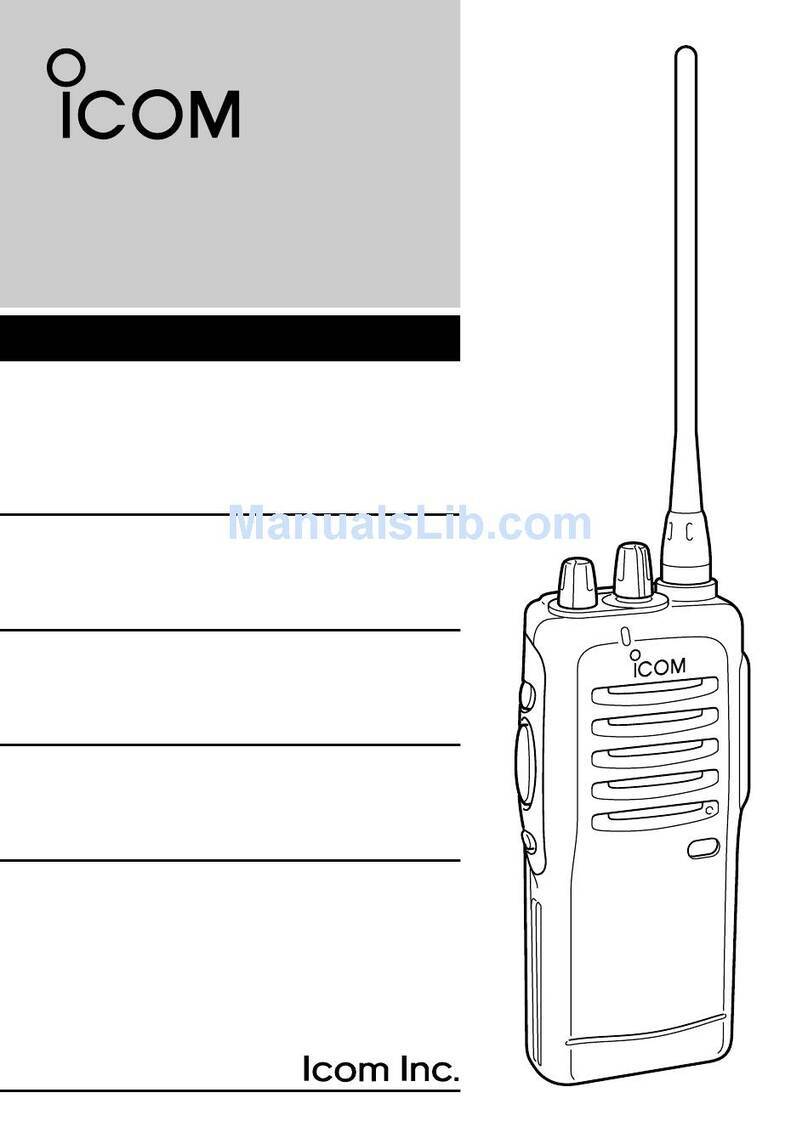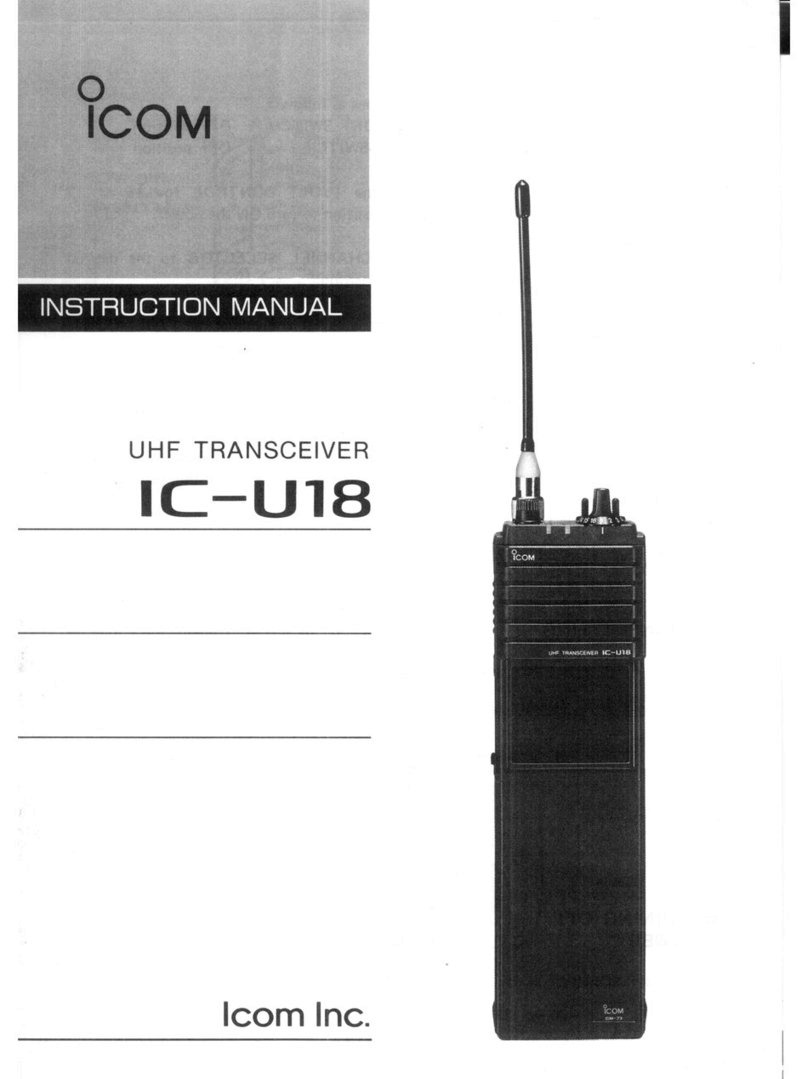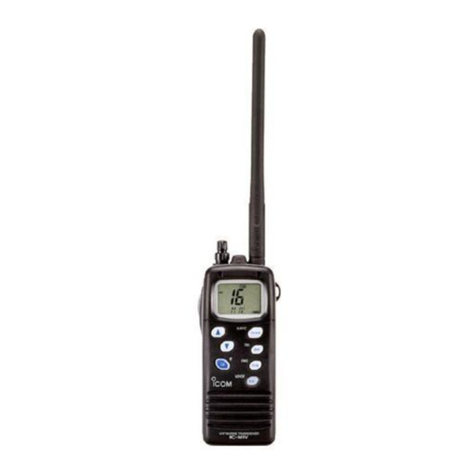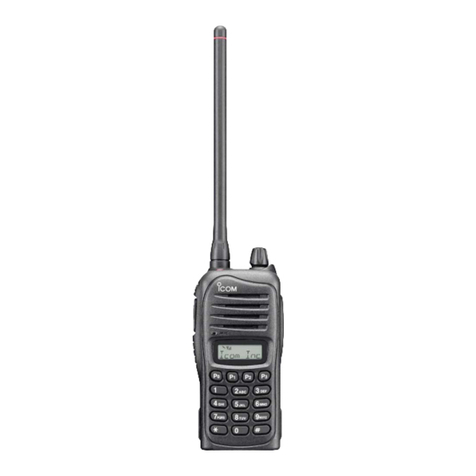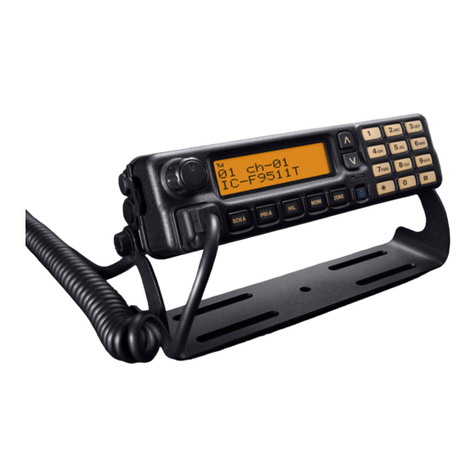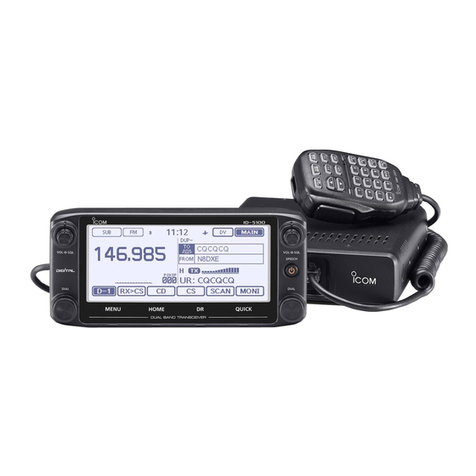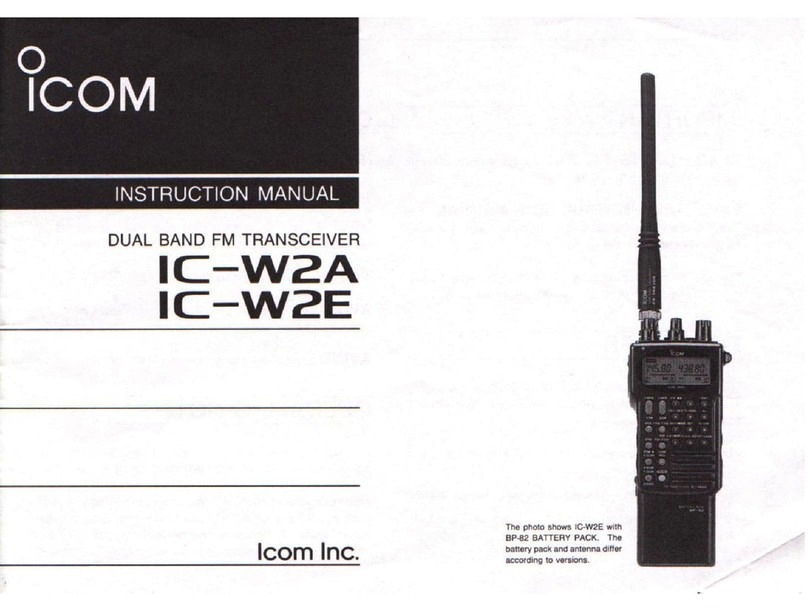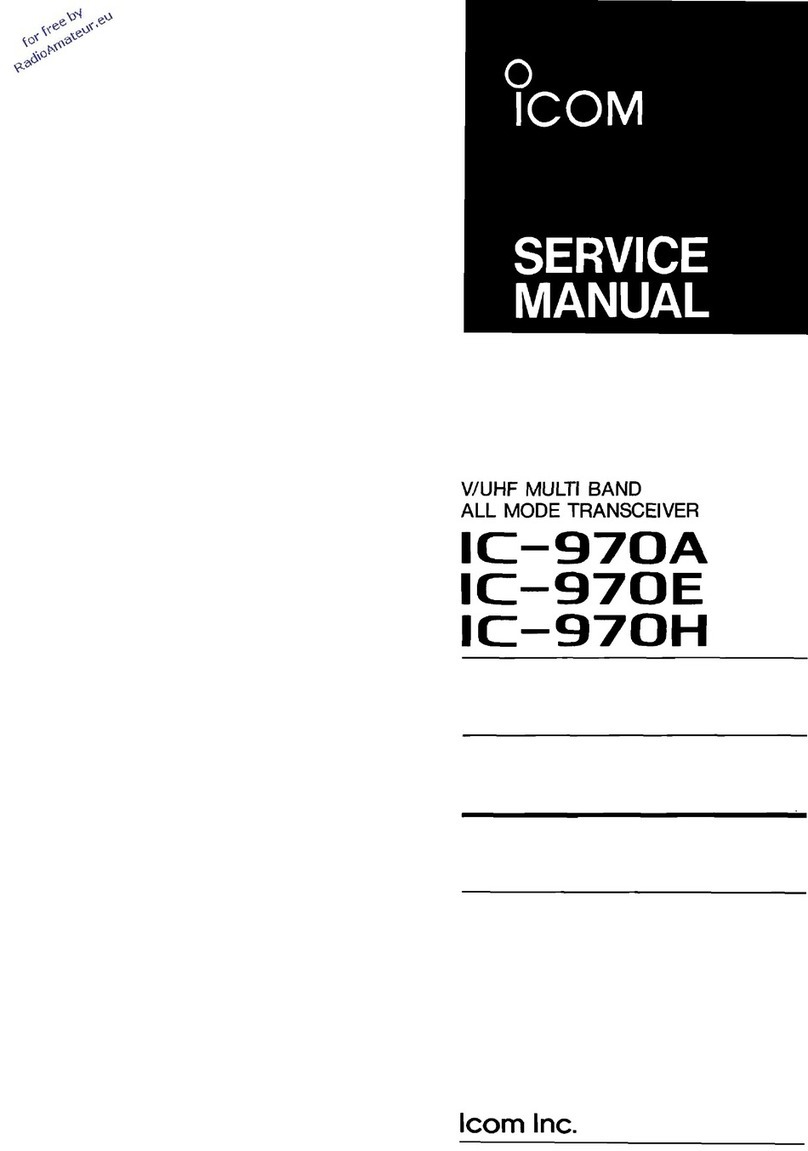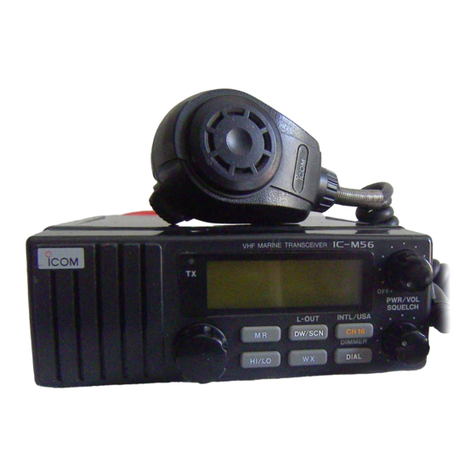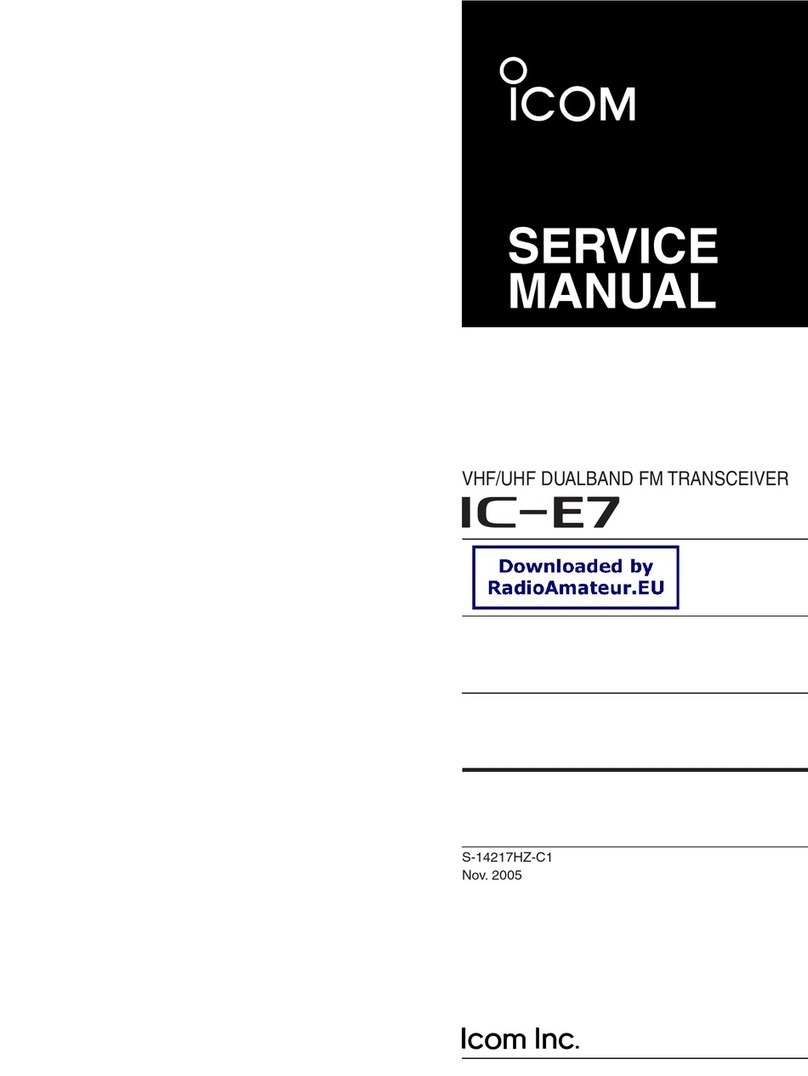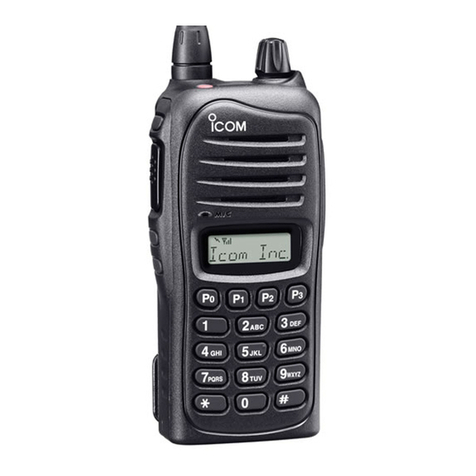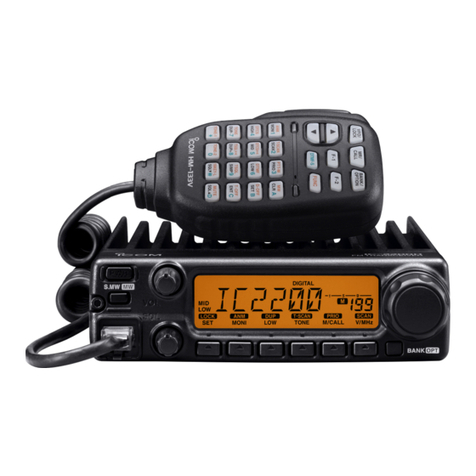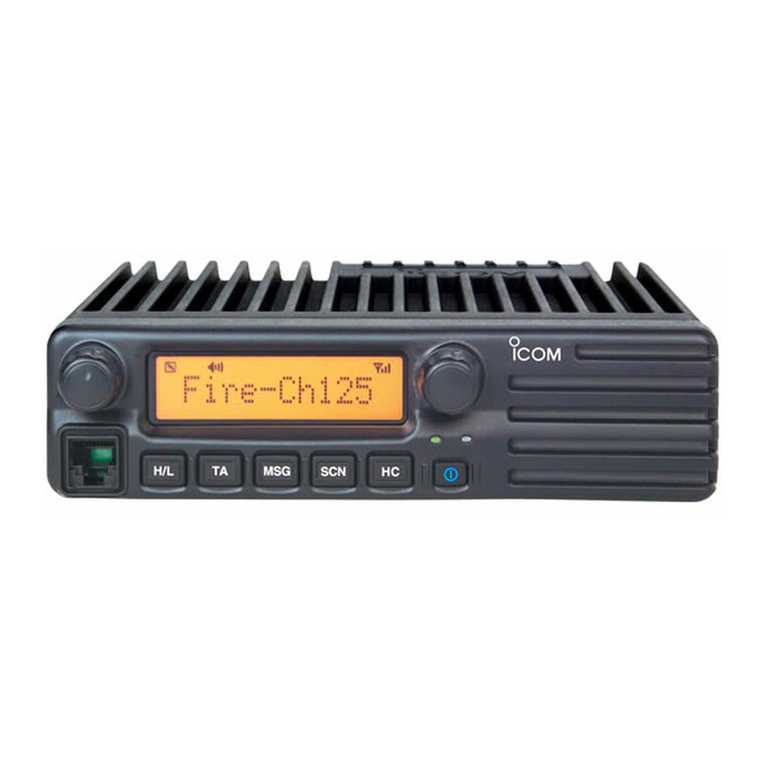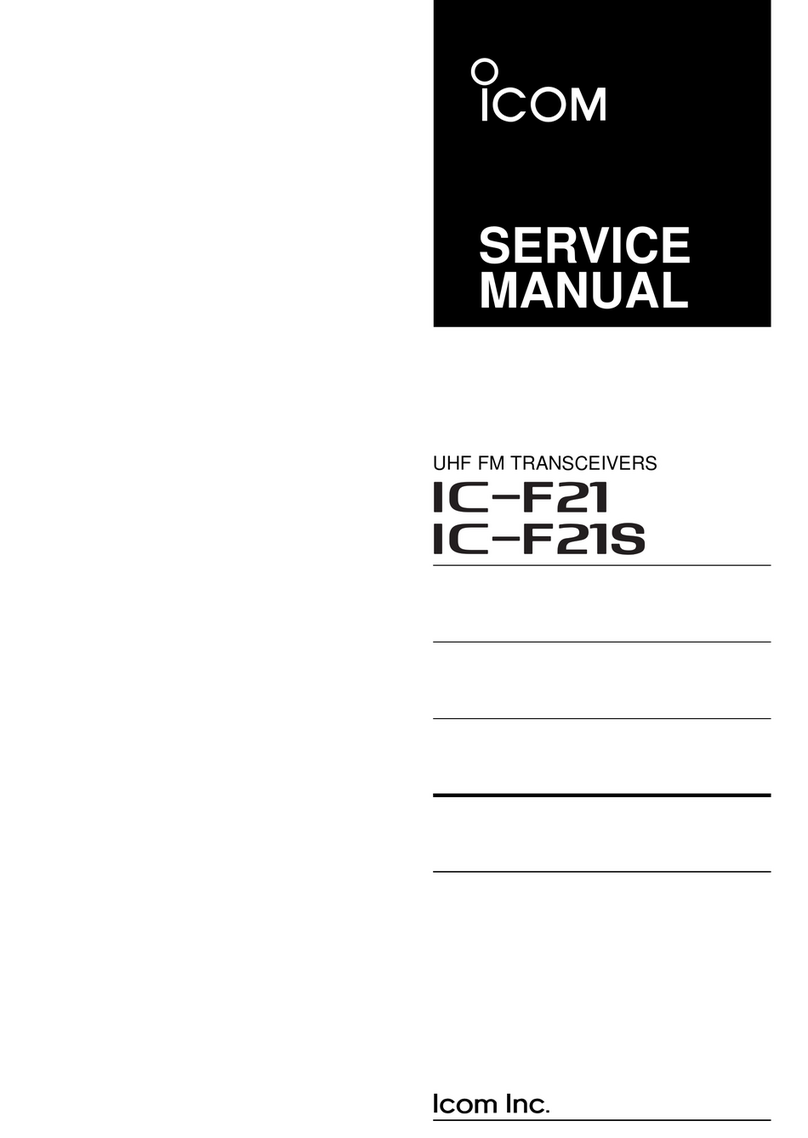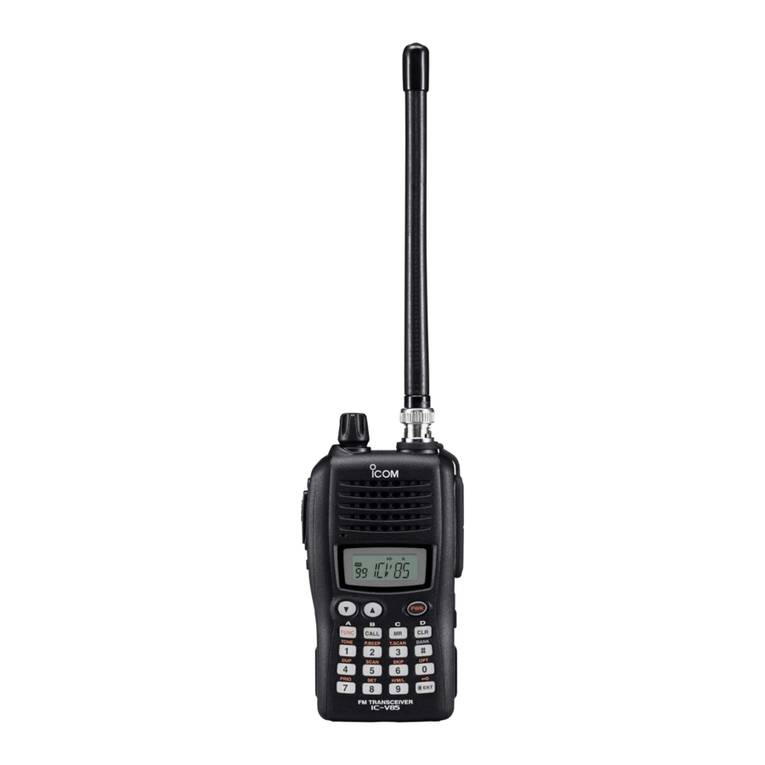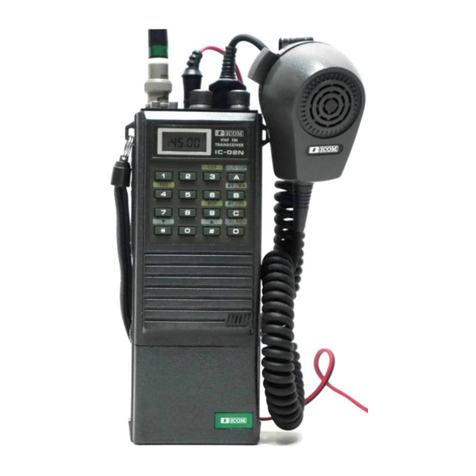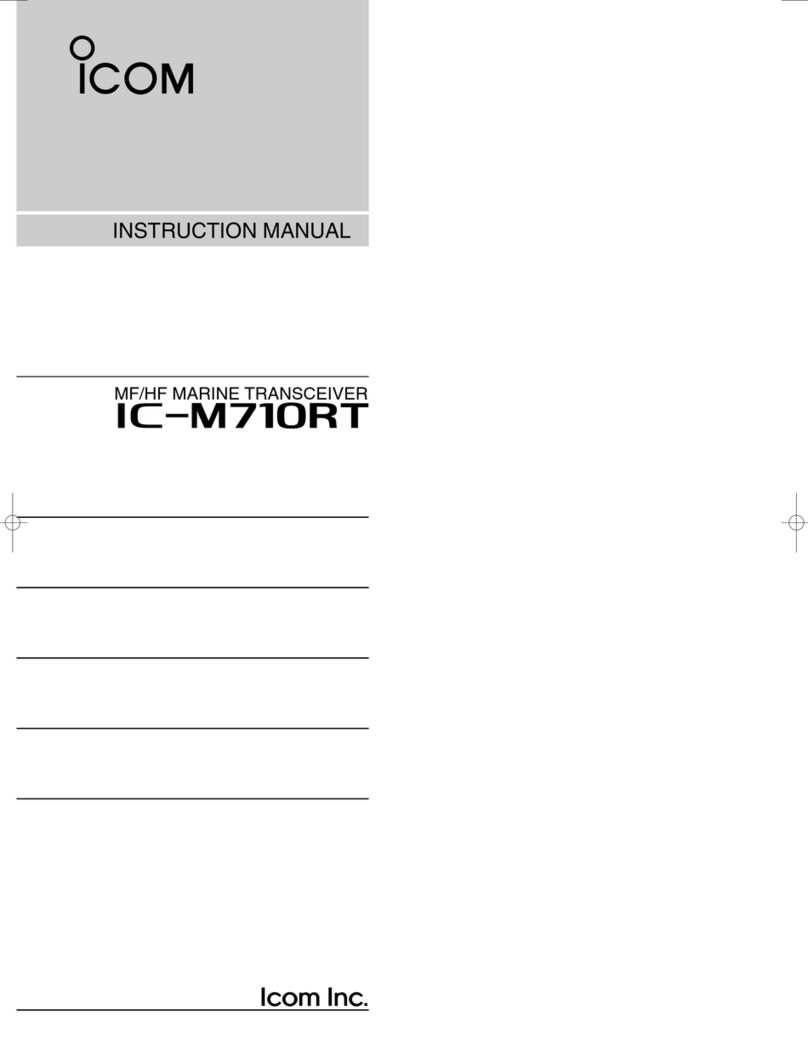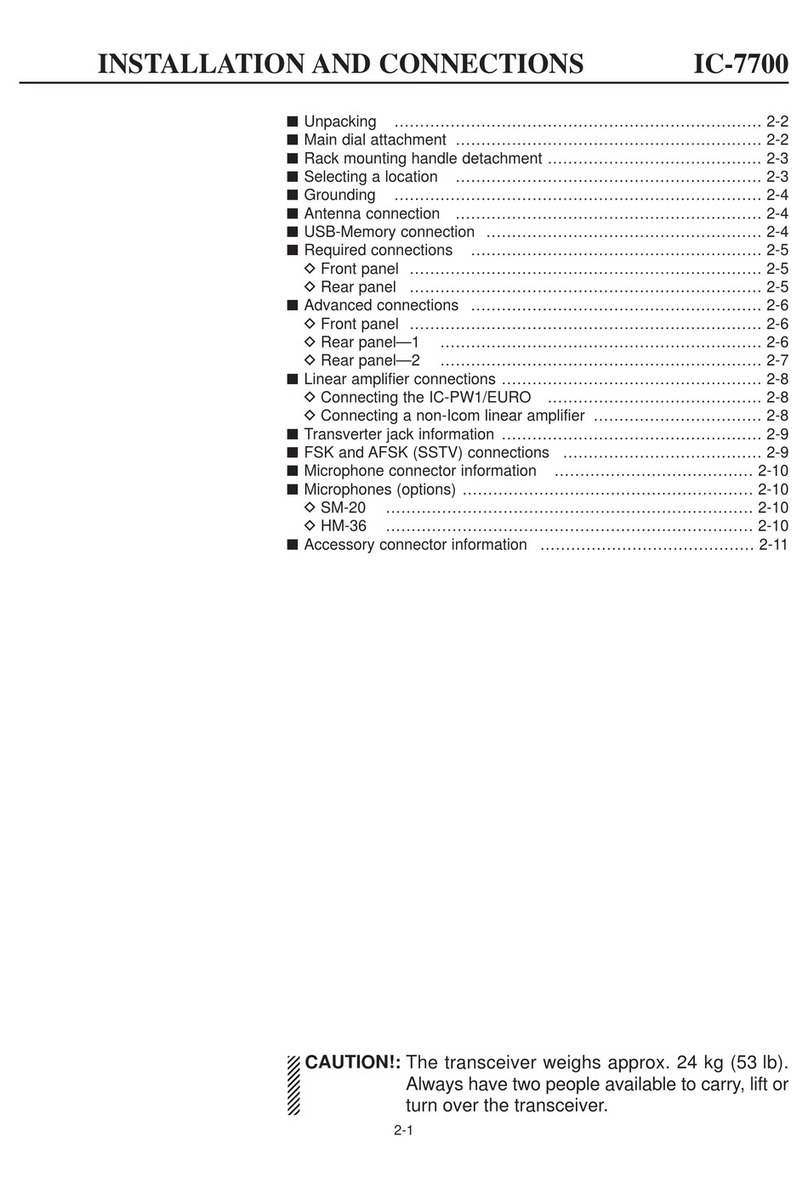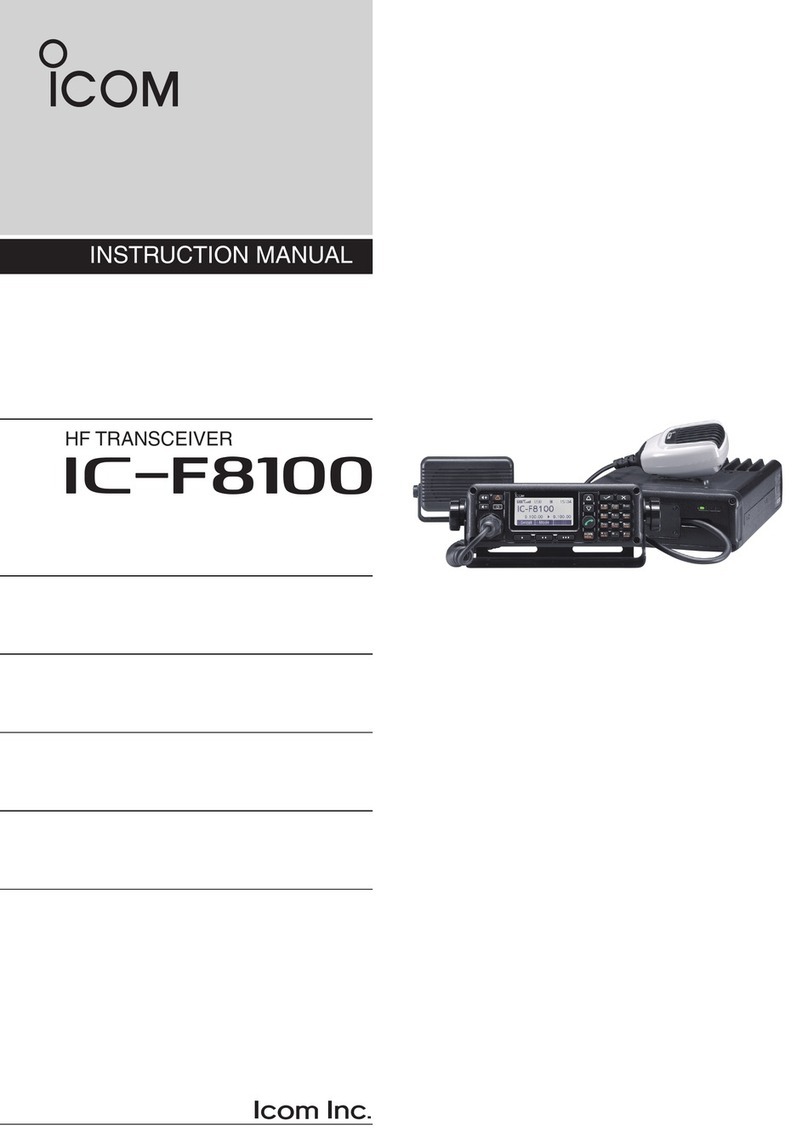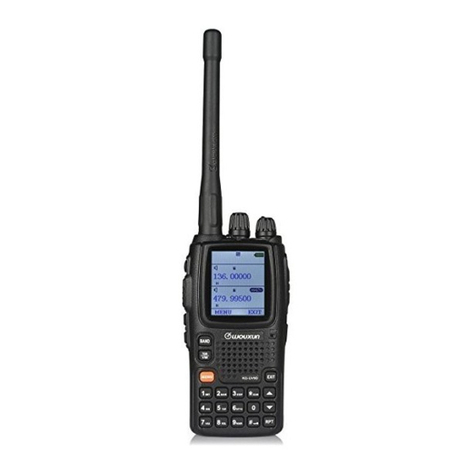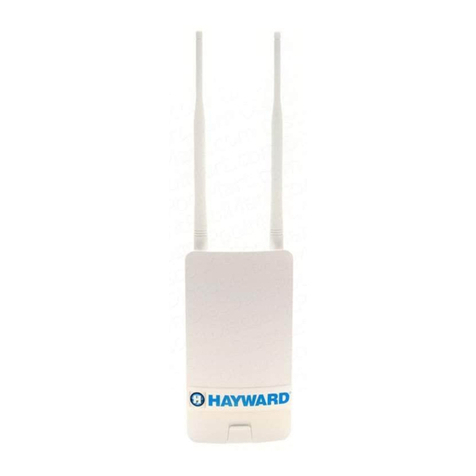Icom IC-7800 User manual

THE TRANSCEIVER
i7800
Instruction Manual
A-6328H-1EX
Printed in Japan
© 2004 Icom Inc.

i
FOREWORD
Congratulations! You are the owner of the world’s most advanced amateur
HF/50 MHz transceiver— IC-7800. The IC-7800 is designed and built with
Icom’s superior technology and craftsmanship. With proper care, this prod-
uct should provide you with years of trouble-free operation.
We would like to take a couple of moments of your time to thank you for
making your IC-7800 your radio of choice, and hope you agree with Icom’s
philosophy of “technology first.” Many hours of research and development
went into the design of your IC-7800.
D
FEATURES
❍Ultimate receiver performance +40 dBm of IP3 characteris-
tics (HF bands only)
❍Built-in Baudot RTTY and PSK31 modulator/demodulator
and direct PC keyboard connection capability for RTTY
and PSK31 operation without a PC
❍Independent receiver circuits for main and sub bands pro-
vide perfect Dualwatch operation
❍Up-graded real-time spectrum scope— center frequency
and fix frequency modes, and mini-scope indications
IMPORTANT
READ THIS INSTRUCTION MANUAL CAREFULLY before at-
tempting to operate the transceiver.
SAVE THIS INSTRUCTION MANUAL. This manual contains im-
portant safety and operating instructions for the IC-7800.
EXPLICIT DEFINITIONS
TRADEMARKS
Icom, Icom Inc. and the are registered trademarks of Icom
Incorporated (Japan) in the United States, the United Kingdom, Germany,
France, Spain, Russia and/or other countries.
WORD DEFINITION
RWARNING Personal injury, fire hazard or electric shock may
occur.
CAUTION Equipment damage may occur.
NOTE If disregarded, inconvenience only. No risk or person-
al injury, fire or electric shock.

ii
PRECAUTIONS
RWARNING HIGH VOLTAGE! NEVER at-
tach an antenna or internal antenna connector during
transmission. This may result in an electrical shock or
burn.
RWARNING! NEVER operate the transceiver
with a headset or other audio accessories at high vol-
ume levels. Hearing experts advise against continuous
high volume operation. If you experience a ringing in
your ears, reduce the volume or discontinue use.
RCAUTION! NEVER change the internal set-
tings of the transceiver. This result in reduced trans-
ceiver performance and/or damage to the transceiver.
RCAUTION! NEVER touch the transceiver top
cover when transmitting continuously for long periods.
It will become hot.
In particular, incorrect settings for transmitter circuits,
such as output power, idling current, etc., might dam-
age the expensive final devices.
The transceiver warranty does not cover any problems
caused by unauthorized internal adjustment.
RCAUTION! The transceiver weighs approx. 25 kg
(55 lb). 2 peoples should be present to carry, lift up or
turn over the transceiver, etc.
RCAUTION! The socket-outlet must be near the
transceiver and must be easily accessible.
RACHTUNG! Die Steckdose muß nabe bei
diesem Gerät angebracht und zugänglich sein.
RNEVER let metal, wire or other objects touch any
internal part or connectors on the rear panel of the
transceiver. This may result in an electric shock.
RNEVER let objects impede the operation of the
cooling fan on the rear panel.
RNEVER expose the transceiver to rain, snow or
any liquids.
RNEVER installing the transceiver in a place with-
out adequate ventilation. Heat dissipation may be af-
fected, and the transceiver may be damaged.
RNEVER operate or touch the transceiver with wet
hands. This may result in an electric shock or damage
the transceiver.
DO NOT
the use of chemical agents such as benzine
or alcohol when cleaning, as they can damage the
transceiver’s surfaces.
DO NOT push the PTT when not actually desiring to
transmit.
AVOID using or placing the transceiver in areas with
temperatures below ±0°C (+32°F) or above +50°C
(+122°F).
AVOID placing the transceiver in excessively dusty en-
vironments or in direct sunlight.
AVOID placing the transceiver against walls or putting
anything on top of the transceiver. This will obstruct
heat dissipation.
Place unit in a secure place to avoid inadvertent use
by children.
BE CAREFUL! The top panel will become hot when
operating the transceiver continuously for long periods.
BE CAREFUL! If a linear amplifier is connected, set
the transceiver’s RF output power to less than the lin-
ear amplifier’s maximum input level, otherwise, the lin-
ear amplifier will be damaged.
Use Icom microphones only (supplied or optional).
Other manufacturer’s microphones have different pin
assignments, and connection to the IC-7800 may dam-
age the transceiver.
The LCD display may have cosmetic imperfections that
appear as small or dark spots. This is not a malfunction
or defect, but a normal characteristic of LCD displays.
During maritime mobile operation, keep the transceiver
and microphone as far away as possible from the mag-
netic navigation compass to prevent erroneous indica-
tions.
Turn [I/O] switch (on the rear panel) OFF and/or dis-
connect the AC power cable from the AC outlet when
you will not use the transceiver for long period of time.
For U.S.A. only
CAUTION: Changes or modifications to this device,
not expressly approved by Icom Inc., could void your
authority to operate this device under FCC regulations.

qAC power cable* ………………………………… 1
wAntenna jumper cables …………………………… 2
eRack mounting handles ……………………… 1 pair
rScrews for rack mounting handles ………… 1 set
tCF (Compact Flash) memory card ……………… 1
yStands ………………………………………… 1 pair
uSpare fuse (FGB 2 A) …………………………… 1
iRCA plugs ………………………………………… 2
oDC power plug …………………………………… 1
!0 2-conductor 1⁄8″plugs …………………………… 3
!1 3-conductor 1⁄8″plugs …………………………… 2
!2 3-conductor 1⁄4″plugs …………………………… 3
!3 ACC plugs (7-pin) ………………………………… 2
!4 ACC plugs (8-pin) ………………………………… 2
*May differ from that shown according to version
iii
SUPPLIED ACCESSORIES
Section 1 PANEL DESCRIPTION
■Front panel ……………………………………………………………… 1-2
■Rear panel ……………………………………………………………… 1-12
■LCD display …………………………………………………………… 1-14
■Screen menu arrangement …………………………………………… 1-15
Section 2 INSTALLATION AND CONNECTIONS
■Unpacking ……………………………………………………………… 2-2
■Antenna jumper cable connection …………………………………… 2-2
■Selecting a location …………………………………………………… 2-2
■Rack mounting handle attachment …………………………………… 2-2
■Grounding ……………………………………………………………… 2-3
■Antenna connection …………………………………………………… 2-3
■CF (Compact Flash) memory card …………………………………… 2-3
■Required connections ………………………………………………… 2-4
DFront panel …………………………………………………………… 2-4
DRear panel …………………………………………………………… 2-4
■Advanced connections ………………………………………………… 2-5
DFront panel …………………………………………………………… 2-5
DRear panel—1 ……………………………………………………… 2-5
TABLE OF CONTENTS
q
!0 !1 !2 !3 !4
yuio
e
wr
t

iv
DRear panel—2 ……………………………………………………… 2-6
■Linear amplifier connections …………………………………………… 2-7
DConnecting the IC-PW1 …………………………………………… 2-7
DConnecting a non-Icom linear amplifier …………………………… 2-7
■Transverter jack information …………………………………………… 2-8
■FSK and AFSK (SSTV) connections ………………………………… 2-8
■Microphone connector information …………………………………… 2-9
■Microphones (options) ………………………………………………… 2-9
DSM-20 ………………………………………………………………… 2-9
DHM-36 ………………………………………………………………… 2-9
■Accessory connector information …………………………………… 2-10
Section 3 BASIC OPERATIONS
■When first applying power (CPU resetting) ………………………… 3-2
■Initial settings …………………………………………………………… 3-2
■Main/Sub band selection ……………………………………………… 3-3
■Selecting VFO/memory mode ………………………………………… 3-3
■Selecting an operating band …………………………………………… 3-4
DUsing the band stacking registers ………………………………… 3-4
■Frequency setting ……………………………………………………… 3-5
DTuning with the main dial …………………………………………… 3-5
DDirect frequency entry with the keypad …………………………… 3-5
DQuick tuning step …………………………………………………… 3-6
DSelecting “kHz” step ………………………………………………… 3-6
D1⁄4tuning step function ……………………………………………… 3-6
DSelecting 1 Hz step ………………………………………………… 3-7
DAuto tuning step function …………………………………………… 3-7
DBand edge warning beep …………………………………………… 3-7
■Operating mode selection ……………………………………………… 3-8
■Volume setting ………………………………………………………… 3-9
■RF gain adjustment …………………………………………………… 3-9
■Squelch level adjustment ……………………………………………… 3-9
■Meter indication selection …………………………………………… 3-10
DMulti-function digital meter ………………………………………… 3-10
DMeter type selection ……………………………………………… 3-11
■Basic transmit operation ……………………………………………… 3-12
DTransmitting ………………………………………………………… 3-12
DMicrophone gain adjustment ……………………………………… 3-12
DDrive gain adjustment ……………………………………………… 3-13
Section 4 RECEIVE AND TRANSMIT
■Operating SSB ………………………………………………………… 4-2
DConvenient functions for receive ……………………………………4-2
DConvenient functions for transmit ……………………………………4-3
DAbout 5 MHz band operation (USA version only) …………………4-3
■Operating CW …………………………………………………………… 4-4
DConvenient functions for receive ……………………………………4-4
DConvenient functions for transmit ……………………………………4-5
DAbout CW reverse mode ……………………………………………4-5
DAbout CW pitch control ………………………………………………4-5
DCW side tone function ………………………………………………4-5
DAPF (Audio Peak Filter) operation …………………………………4-6
DAbout 137 kHz band operation (Europe, UK, Italy, Spain, France
versions only) …………………………………………………………4-6
■Electronic keyer functions ……………………………………………… 4-7
TABLE OF CONTENTS

DMemory keyer screen …………………………………………………4-8
DEditing a memory keyer ………………………………………………4-9
DContest number set mode …………………………………………4-10
DKeyer set mode ………………………………………………………4-11
■Operating RTTY (FSK) ……………………………………………… 4-13
DConvenient functions for receive …………………………………4-14
DAbout RTTY reverse mode …………………………………………4-14
DTwin peak filter ………………………………………………………4-14
DFunctions for the RTTY decoder indication ………………………4-15
DSetting the decoder threshold level ………………………………4-15
DRTTY memory transmission ………………………………………4-16
DAutomatic transmission/reception setting …………………………4-16
DEditing RTTY memory ………………………………………………4-17
DRTTY decode set mode ……………………………………………4-18
DData saving …………………………………………………………4-20
■Operating PSK ………………………………………………………… 4-21
DConvenient functions for receive …………………………………4-22
DAbout BPSK and QPSK mode ……………………………………4-22
DFunctions for the PSK decoder indication ………………………4-23
DSetting the decoder threshold level ………………………………4-23
DPSK memory transmission …………………………………………4-24
DAutomatic transmission/reception setting …………………………4-24
DEditing PSK memory ………………………………………………4-25
DPSK decode set mode ………………………………………………4-26
DData saving …………………………………………………………4-28
■Operating AM ………………………………………………………… 4-29
DConvenient functions for receive …………………………………4-29
DConvenient functions for transmit …………………………………4-30
■Operating FM ………………………………………………………… 4-31
DConvenient functions for receive …………………………………4-31
DConvenient functions for transmit …………………………………4-31
■Repeater operation …………………………………………………… 4-32
DRepeater tone frequency setting …………………………………4-32
■Tone squelch operation ……………………………………………… 4-33
■Data mode (AFSK) operation ………………………………………… 4-34
Section 5 FUNCTIONS FOR RECEIVE
■Spectrum scope screen ……………………………………………… 5-2
DCenter mode ………………………………………………………… 5-2
DFix mode ……………………………………………………………… 5-3
DMini scope screen indication ……………………………………… 5-4
DScope set mode ……………………………………………………… 5-4
■Preamplifier ……………………………………………………………… 5-9
■Attenuator ……………………………………………………………… 5-9
■RIT function …………………………………………………………… 5-10
DRIT monitor function …………………………………………………5-10
■AGC function …………………………………………………………… 5-11
DSelecting the preset value …………………………………………5-11
DAdjusting the AGC time constant …………………………………5-11
DSetting the AGC time constant preset value ………………………5-11
■Twin PBT operation …………………………………………………… 5-12
■IF filter selection ……………………………………………………… 5-13
DIF filter selection …………………………………………………… 5-13
DFilter passband width setting (except FM mode) ……………… 5-13
DRoofing filter selection ……………………………………………… 5-14
v
TABLE OF CONTENTS

vi
DDSP filter shape …………………………………………………… 5-14
DFilter shape set mode ……………………………………………… 5-14
■Dualwatch operation ………………………………………………… 5-16
■Noise blanker ………………………………………………………… 5-17
DNB set mode ………………………………………………………… 5-17
■Noise reduction ………………………………………………………… 5-18
■Dial lock function ……………………………………………………… 5-18
■Notch function ………………………………………………………… 5-19
■Digital selector ………………………………………………………… 5-19
Section 6 FUNCTIONS FOR TRANSMIT
■VOX function …………………………………………………………… 6-2
DUsing the VOX function …………………………………………… 6-2
DAdjusting the VOX function ………………………………………… 6-2
DVOX set mode ……………………………………………………… 6-2
■Break-in function ………………………………………………………… 6-3
DSemi break-in operation …………………………………………… 6-3
DFull break-in operation ……………………………………………… 6-3
■∂TX function …………………………………………………………… 6-4
D∂TX monitor function ………………………………………………… 6-4
■Monitor function ………………………………………………………… 6-4
■Transmit filter width setting (SSB only) ……………………………… 6-5
■Speech compressor (SSB only) ……………………………………… 6-5
■Split frequency operation ……………………………………………… 6-6
■Quick split function ……………………………………………………… 6-7
DSplit lock function …………………………………………………… 6-7
Section 7 VOICE RECORDER FUNCTIONS
■About digital voice recorder …………………………………………… 7-2
■Recording a received audio …………………………………………… 7-3
DBasic recording ……………………………………………………… 7-3
DOne-touch recording ………………………………………………… 7-3
■Playing the recorded audio …………………………………………… 7-4
DBasic playing ………………………………………………………… 7-4
DOne-touch playing …………………………………………………… 7-4
■Protect the recorded contents ………………………………………… 7-5
■Erasing the recorded contents ………………………………………… 7-5
■Recording a message for transmit …………………………………… 7-6
DRecording …………………………………………………………… 7-6
DConfirming a message for transmit ………………………………… 7-6
■Programming a memory name ……………………………………… 7-7
■Sending a recorded message ………………………………………… 7-8
DTransmit level setting ……………………………………………… 7-8
■Voice set mode ………………………………………………………… 7-9
■Saving a voice memory into the CF card …………………………… 7-10
DSaving the received audio memory ……………………………… 7-10
DSaving the TX memory …………………………………………… 7-10
Section 8 MEMORY OPERATION
■Memory channels ……………………………………………………… 8-2
■Memory channel selection …………………………………………… 8-2
DUsing the [Y]/[Z] keys ……………………………………………… 8-2
DUsing the keypad …………………………………………………… 8-2
■Memory list screen ……………………………………………………… 8-3
DSelecting a memory channel using the memory list screen …… 8-3
DConfirming programmed memory channels ……………………… 8-3
TABLE OF CONTENTS

■Memory channel programming ……………………………………… 8-4
DProgramming in VFO mode ………………………………………… 8-4
DProgramming in memory mode …………………………………… 8-4
■Frequency transferring ………………………………………………… 8-5
DTransferring in VFO mode ………………………………………… 8-5
DTransferring in memory mode ……………………………………… 8-5
■Memory names ………………………………………………………… 8-6
DEditing (programming) memory names …………………………… 8-6
■Memory clearing ………………………………………………………… 8-6
■Memo pads ……………………………………………………………… 8-7
DWriting frequencies and operating modes into memo pads …… 8-7
DCalling up a frequency from a memo pad ………………………… 8-7
Section 9 SCANS
■Scan types ……………………………………………………………… 9-2
■Preparation ……………………………………………………………… 9-2
■Voice squelch control function ………………………………………… 9-3
■Scan set mode ………………………………………………………… 9-3
■Programmed scan operation ………………………………………… 9-4
■∂F scan operation ……………………………………………………… 9-4
■Fine programmed scan/∂F scan ……………………………………… 9-5
■Memory scan operation ………………………………………………… 9-6
■Select memory scan operation ……………………………………… 9-6
■Setting select memory channels ……………………………………… 9-7
DSetting in scan screen ……………………………………………… 9-7
DSetting in memory list screen ……………………………………… 9-7
DErasing the select scan setting …………………………………… 9-7
■Tone scan ……………………………………………………………… 9-8
Section 10 ANTENNA TUNER OPERATION
■Antenna connection and selection ………………………………… 10-2
■Antenna memory settings …………………………………………… 10-3
DAntenna type selection …………………………………………… 10-3
DTemporary memory ………………………………………………… 10-4
DAntenna selection mode …………………………………………… 10-4
■Antenna tuner operation ……………………………………………… 10-5
DTuner operation …………………………………………………… 10-5
DIf the tuner cannot tune the antenna …………………………… 10-6
Section 11 CLOCK AND TIMERS
■Time set mode ………………………………………………………… 11-2
■Daily timer setting ……………………………………………………… 11-3
■Setting sleep timer …………………………………………………… 11-4
■Timer operation ………………………………………………………… 11-4
Section 12 SET MODE
■Set mode description ………………………………………………… 12-2
DSet mode operation ………………………………………………… 12-2
DScreen arrangement ……………………………………………… 12-3
■Level set mode ………………………………………………………… 12-4
■ACC set mode ………………………………………………………… 12-6
■Display set mode …………………………………………………… 12-11
■Miscellaneous (Others) set mode ………………………………… 12-13
■CF card set menu …………………………………………………… 12-21
DCF card set screen arrangement ……………………………… 12-21
DSave option set mode …………………………………………… 12-21
vii
TABLE OF CONTENTS

viii
DLoad option set mode …………………………………………… 12-22
■File saving …………………………………………………………… 12-23
■File loading …………………………………………………………… 12-24
■Changing the file name ……………………………………………… 12-25
■Deleting a file ………………………………………………………… 12-26
■Formatting the CF card ……………………………………………… 12-26
Section 13 MAINTENANCE
■Troubleshooting ……………………………………………………… 13-2
DTransceiver power ………………………………………………… 13-2
DTransmit and receive ……………………………………………… 13-2
DScanning …………………………………………………………… 13-3
DDisplay ……………………………………………………………… 13-3
■Main dial brake adjustment ………………………………………… 13-3
■Voice synthesizer operation ………………………………………… 13-3
■SWR reading …………………………………………………………… 13-4
■Screen type and font selections …………………………………… 13-4
■Frequency calibration (approximate) ……………………………… 13-5
■Opening the transceiver’s case ……………………………………… 13-6
■Clock backup battery replacement ………………………………… 13-6
■Fuse replacement …………………………………………………… 13-7
■Resetting the CPU …………………………………………………… 13-7
■About protection indications ………………………………………… 13-8
Section 14 CONTROL COMMAND
■Remote jack (CI-V) information ……………………………………… 14-2
DCI-V connection example ………………………………………… 14-2
DData format ………………………………………………………… 14-2
DCommand table …………………………………………………… 14-9
DTo send/read memory contents …………………………………… 14-9
DBand stacking register …………………………………………… 14-9
DCodes for memory keyer contents ……………………………… 14-9
DCodes for memory name, opening message
and clock 2 name contents ……………………………………… 14-9
DOffset frequency setting ………………………………………… 14-10
DRepeater tone/tone squelch frequency setting ………………… 14-10
DSSB transmission passband width setting …………………… 14-10
DColor setting ……………………………………………………… 14-10
DBandscope edge frequency setting …………………………… 14-10
DData mode with filter width setting ……………………………… 14-10
DAntenna memory setting ………………………………………… 14-10
Section 15 SPECIFICATIONS AND OPTIONS
■Specifications ………………………………………………………… 15-2
DGeneral ……………………………………………………………… 15-2
DTransmitter ………………………………………………………… 15-2
DReceiver …………………………………………………………… 15-3
DAntenna tuner ……………………………………………………… 15-3
■Options ………………………………………………………………… 15-4
TABLE OF CONTENTS

1-1
PANEL DESCRIPTION Section 1
■Front panel ……………………………………………………………… 1-2
■Rear panel ……………………………………………………………… 1-12
■LCD display …………………………………………………………… 1-14
■Screen menu arrangement …………………………………………… 1-15

1-2
■Front panel
qPOWER SWITCH [POWER] (p. 3-2)
➥Push to turn the transceiver power ON.
• The [POWER] indicator above this switch lights green
when powered ON.
➥Push for 1 sec. to turn the transceiver power
OFF.
• The [POWER] indicator lights orange even the trans-
ceiver is powered OFF when the internal power sup-
ply is switched ON.
wTRANSMIT SWITCH [TRANSMIT]
Selects transmitting or receiving.
• The [TX] indicator lights red while transmitting and the
[RX] indicator lights green when the squelch is open.
eANTENNA TUNER SWITCH [TUNER] (p. 10-5)
➥Turn the internal antenna tuner ON and OFF (by-
pass) when pushed momentarily.
• The [TUNER] indicator above this switch lights green
when the tuner is turned ON, goes off when turned
OFF (bypassed).
➥Tunes the antenna manually when pushed for
1 sec.
• The [TUNER] indicator blinks red during manual tun-
ing.
• When the tuner cannot tune the antenna, the tuning
circuit is bypassed automatically after 20 sec.
rTIMER SWITCH [TIMER] (p. 11-4)
➥Turns the sleep or daily timer function ON and
OFF when pushed.
• The [TIMER] indicator above this switch lights green
when the timer is in use.
➥Enters timer set mode when pushed for 1 sec.
tHEADPHONE JACK [PHONES]
Accepts headphones.
• Output power: 50 mW with an 8 Ωload.
• When headphones are connected, the internal speaker
or connected external speaker does not function.
yELECTRONIC KEYER JACK [ELEC-KEY] (p. 2-4)
Accepts a paddle to activate the internal electronic
keyer for CW operation.
• Selection between the internal electronic keyer, bug-key
and straight key operation can be made in keyer set
mode. (p. 4-12)
• A straight key jack is separately available on the rear
panel. See [KEY] on p. 1-13.
• Keyer polarity (dot and dash) can be reversed in keyer
set mode. (p. 4-12)
• 4-channel memory keyer is available for your conve-
nience. (p. 4-8)
uMICROPHONE CONNECTOR [MIC]
Accepts an optional microphone.
• See p. 15-4 for appropriate microphones.
• See p. 2-9 for microphone connector information.
(dot)
(com)
(dash)
Turn the internal power supply ON in advance. The
internal power supply switch is located on the rear
panel. (p. 3-2)
1PANEL DESCRIPTION
q
w
e
r
t
y
u
io !0 !1 !2 !3
!4 !5 !6 !7 !8

1-3
iMIC GAIN CONTROL [MIC]
Adjusts microphone input gain.
• The transmit audio tone in SSB, AM and FM modes can
be adjusted independently in set mode. (p. 12-4)
✔
How to set the microphone gain.
Set the [MIC] control so that the ALC meter sometimes
swings during normal voice transmission in SSB, AM or FM
mode.
oRF POWER CONTROL [RF PWR] (p. 3-12)
Continuously varies the RF output power from min-
imum (5 W*) to maximum (200 W*).
*AM mode: 5 W to 50 W
!0 VOX/BREAK-IN SWITCH [VOX/BK-IN]
➥Push to turn the VOX function ON and OFF dur-
ing SSB, AM and FM mode operation. (p. 6-2)
➥Push to turn the break-in function ON (semi-break-
in, full break-in) and OFF during CW mode opera-
tion. (p. 6-3)
➥Push for 1 sec. to enter VOX set mode. (p. 6-2)
✔
What is the VOX function?
The VOX function (voice operated transmission) starts trans-
mission without pushing the transmit switch or PTT switch
when you speak into the microphone; then, automatically re-
turns to receive when you stop speaking.
✔
What is the break-in function?
The break-in function switches transmit and receive with CW
keying. Full break-in (QSK) can monitor the receive signal
during keying.
!1 ELECTRONIC CW KEYER SPEED CONTROL
[KEY SPEED] (p. 4-4)
Adjusts the internal electronic CW keyer’s speed.
• 6 wpm (min.) to 60 wpm (max.) can be set.
!2 BREAK-IN DELAY CONTROL [DELAY] (p. 6-3)
Adjusts the transmit-to-receive switching delay time
for CW semi break-in operations.
!3 MONITOR SWITCH [MONI] (p. 6-4)
Monitors your transmitted IF signal.
• The CW sidetone functions regardless of [MONI] switch
setting in CW mode.
• The [MONI] indicator above this switch lights green
while the function is activated.
!4 MEMORY CARD SLOT [CF CARD] (p. 2-3)
Insert the supplied CF (Compact Flash) memory
card for both reading/storing a variety of trans-
ceiver’s information or data.
• The indicator beside the slot lights or blinks when the
transceiver accessing to the memory card for reading or
writing data.
• Push-in the eject button to remove the memory card.
!5 MONITOR GAIN CONTROL [MONI GAIN] (p. 6-4)
Adjusts the transmit IF signal monitor level.
!6 COMPRESSION LEVEL CONTROL [COMP]
(p. 6-5)
Adjusts the speech compression level in SSB.
!7 DRIVE GAIN CONTROL [DRIVE] (p. 3-13)
Adjusts the amplifying gain level at the drive stage.
Activated in all modes (except SSB with [COMP] OFF).
!8 VOX GAIN CONTROL [VOX GAIN] (p. 6-2)
Adjusts the transmit/receive switching threshold
level for VOX operation.
Low
sensitivity
High
sensitivity
Push
Decreases
Increases
Push
Monitor gain
decreases
Monitor gain
increases
Push
Monitor gain
decreases
Monitor gain
increases
Push
Long delay for
slow speed keying
Short delay for
high speed keying
Max.
60 wpm
Min.
6 wpm
Increases
Decreases
Recommended level for
an Icom microphone
Decreases Increases
1
PANEL DESCRIPTION

1-4
■Front panel (continued)
!9 AGC CONTROL [AGC] (for MAIN band; p. 5-11)
@0 AGC CONTROL [AGC] (for SUB band; p. 5-11)
Adjusts the AGC circuit time constant.
• To use the set value, push appropriate band’s [AGC VR]
([AGC VR] indicator lights).
@1 AGC VOLUME SWITCH [AGC VR]
(for MAIN band; p. 5-11)
@2 AGC VOLUME SWITCH [AGC VR]
(for SUB band; p. 5-11)
➥Push to toggle [AGC] control usage ON and OFF.
• The set level with [AGC] control is used for the oper-
ation when switched ON.
• The [AGC VR] indicator above this switch lights
green when the control setting is in use.
➥Turns the AGC function OFF when pushed for
1 sec.
@3 AF CONTROL [AF] (inner control; for SUB band)
@4 AF CONTROL [AF] (inner control; for MAIN band)
Varies the audio output level from the speaker.
@5 RF GAIN CONTROL [RF] (outer control; for MAIN
band; p. 3-9)
@6 RF GAIN CONTROL [RF] (outer control; for SUB
band; p. 3-9)
Adjusts the RF gain level.
While rotating the RF gain control, noise may be
heard. This comes from the DSP unit and does
not indicate an equipment malfunction.
@7 SQUELCH CONTROL [SQL] (outer control; for
MAIN band; p. 3-9)
@8 SQUELCH CONTROL [SQL] (outer control; for
SUB band; p. 3-9)
Adjusts the squelch threshold level. The squelch re-
moves noise output from the speaker (closed con-
dition) when no signal is received.
• The squelch is particularly effective for FM. It is also
available for other modes.
• 11 to 12 o’clock position is recommended for any set-
ting of the [SQL] control.
Deep
Deep
S-meter
squelch
Noise squelch
Squelch
is open.
Squelch
threshold
Shallow
Shallow
Sensitivity
increases
Sensitivity
decreases
Audio output
increases
Audio output
decreases
Slow
Fast
1PANEL DESCRIPTION
@6
@4
@5
@1
@2
@3
@7 @8
#2
!9
#0 #1@9
@0
#3 #4

1-5
@9 MULTI-FUNCTION SWITCHES
Push to select the functions indicated in the LCD
display to the right of these switches.
• Functions vary depending on the operating condition.
➥Selects the antenna connector from
ANT1, ANT2, ANT3 and ANT4 when
pushed. (p. 10-2)
➥Displays antenna selection memory
when pushed for 1 sec.
• When the receive antenna is activated, the
antenna which is connected to the [ANT4] is
used for receive only.
When a transverter is in use, this [ANT]
does not function and ‘XVERT’ appears.
➥Selects RF power (Po), SWR, ALC,
COMP, VDor IDmetering during transmit.
(p. 3-10)
➥Switches the multi-function digital meter
ON and OFF when pushed for 1 sec.
(p. 3-10)
➥Selects one of 2 receive RF preamps or
bypasses them. (p. 5-9)
• “P. AMP1” activates 10 dB preamp.
•
“P. AMP2” activates 16 dB high-gain preamp.
✔
What is the preamp?
The preamp amplifies received signals in the front end cir-
cuit to improve the S/N ratio and sensitivity. Select “P. AMP1”
or “P. AMP2” when receiving weak signals.
➥Selects 6 dB, 12 dB or 18 dB attenuator
when pushed. (p. 5-9)
➥Selects 3 dB, 6 dB, 9 dB, 12 dB, 18 dB,
or 21 dB attenuator when pushed for
1 sec. (p. 5-9)
✔
What is the attenuator?
The attenuator prevents a desired signal from distorting
when very strong signals are near the desired frequency, or
when very strong electric fields, such as from a broadcast-
ing station, are near your location.
➥Activates or selects fast, middle or slow
AGC time constant when pushed. (p. 5-
11)
• “FAST” is only available for FM mode.
➥Enters the AGC set mode when pushed
for 1 sec. (p. 5-11)
AGC time constant can be set between 0.1 to
8.0 sec. (depends on mode), or turned OFF. While
“OFF” is selected, the S-meter does not function.
✔
What is the AGC?
The AGC controls receiver gain to produce a constant audio
output level, even when the received signal strength is varied
by fading, etc. Select “FAST” for tuning and select “MID” or
“SLOW” depending on the receiving condition.
➥Turns the speech compressor ON and
OFF in SSB mode. (p. 6-5)
➥Switches the narrow, middle or wide
transmit filter when pushed for 1 sec.
✔
What is the speech compressor?
The speech compressor compresses the transmitter audio
input to increase the average audio output level. Therefore, talk
power is increased. This function is effective for long distance
communication or when propagation conditions are poor.
➥Turns the 1⁄4function ON and OFF in
SSB data, CW, RTTY and PSK modes.
(p. 3-6)
•1⁄4function sets dial rotation to 1⁄4of normal
for fine tuning.
➥Switches the tone encoder, tone squelch
function and no tone operation when
pushed in FM mode. (pgs. 4-32, 4-33)
➥Enters the tone set mode when pushed
for 1 sec. in FM mode. (pgs. 4-32, 4-33)
➥Switches the voice squelch control func-
tion ON and OFF. (p. 9-3)
#0 TRANSMIT INDICATOR [TX] (for MAIN band)
#1 TRANSMIT INDICATOR [TX] (for SUB band)
Lights red while transmitting.
• SUB band’s [TX] indicator lights only when the split op-
eration.
#2 ANTI VOX CONTROL [ANTI VOX] (p. 6-2)
Adjusts the VOX deactivate level to prevent un-
wanted VOX control from the speaker audio.
#3 LCD CONTRAST CONTROL [CONTRAST]
Adjusts the LCD contrast.
#4 LCD BRIGHTNESS CONTROL [BRIGHT]
Adjusts the LCD brightness.
Dark
Bright
Push
Low
contrast
High
contrast
Push
Decreases
cut-off level
Increases
cut-off level
Push
1
PANEL DESCRIPTION

1-6
■Front panel (continued)
#5 NOISE REDUCTION SWITCH [NR] (for MAIN
band; p. 5-18)
#6 NOISE REDUCTION SWITCH [NR] (for SUB band;
p. 5-18)
Push to switches the noise reduction ON and OFF.
• The [NR] indicator above this switch lights green when
the function is activated.
#7 NOISE REDUCTION LEVEL CONTROL [NR]
(inner control; for SUB band; p. 5-18)
#8 NOISE REDUCTION LEVEL CONTROL [NR]
(inner control; for MAIN band; p. 5-18)
Adjusts the noise reduction level when the noise re-
duction is in use. Set for maximum readability.
• To activate this control, push the appropriate band’s
[NR] in advance.
#9 NOISE BLANKER CONTROL [NB] (outer control;
for MAIN band; p. 5-17)
$0 NOISE BLANKER CONTROL [NB] (outer control;
for SUB band; p. 5-17)
Adjust the noise blanker threshold level.
• To activate this control, push appropriate band’s [NB]
switch in advance.
$1 NOISE BLANKER SWITCH [NB] (for MAIN band;
p. 5-17)
$2 NOISE BLANKER SWITCH [NB] (for SUB band;
p. 5-17)
➥Switches the noise blanker ON and OFF when
pushed. The noise blanker reduces pulse-type
noise such as that generated by automobile igni-
tion systems. This function cannot be used for
FM, or non-pulse-type noise.
• The [NB] indicator above this switch lights green
while the function is activated.
➥Enters blank-width set mode when pushed for
1 sec.
$3 RECEIVE INDICATOR [RX] (for MAIN band)
$4 RECEIVE INDICATOR [RX] (for SUB band)
Lights green while receiving a signal and when the
squelch is open.
$5
LOCK INDICATOR [LOCK] (for MAIN band; p. 5-18)
$6 LOCK INDICATOR [LOCK] (for SUB band; p. 5-18)
Lights when the dial lock function is activated.
$7 SPLIT OPERATION INDICATOR [SPLIT]
Lights during split frequency operation.
$8 LCD FUNCTION DISPLAY (p. 1-14)
Shows the operating frequency, function switch
menus, spectrum scope screen, memory channel
screen, set mode settings, etc.
Deep
Shallow
Increases
Decreases
1PANEL DESCRIPTION
#5
#6
$1 $2
#8
#9
$5$3 $6 $9$4$7 $8
#7
$0
%0 %1 %3 %4 %6%2 %5

1-7
$9 MEMORY UP/DOWN SWITCHES [Y]/[Z](p. 8-2)
Push to select the memory channel number for the
selected readout.
• Memory channels can be selected both in VFO and
memory modes.
%0 LCD FUNCTION SWITCHES [F-1]–[F-7]
Push to select the function indicated in the LCD dis-
play above these switches.
• Functions vary depending on the operating condition.
%1 MODE SWITCHES
Selects the desired mode. (p. 3-8)
• Announces the selected mode. (p. 12-16)
➥Selects USB and LSB modes alternately.
➥Selects CW and CW-R (CW reverse)
modes alternately.
➥Switches RTTY and PSK mode when
pushed.
➥Switches RTTY and RTTY-R (RTTY re-
verse) mode when pushed for 1 sec. in
RTTY mode.
➥Switches PSK and PSK-R (PSK reverse)
mode when pushed for 1 sec. in PSK
mode.
➥Selects AM and FM modes alternately.
➥Selects SSB, AM or FM data mode (USB-
D, LSB-D, AM-D, FM-D) when pushed in
SSB, AM or FM mode, respectively.
➥Switches D1, D2 and D3 when pushed
for 1 sec.
%2 MINI SPECTRUM SCOPE SWITCH [M.SCOPE]
(p. 5-4)
Turns the mini spectrum scope screen indication
ON and OFF.
• The mini spectrum scope screen can be indicated with
another screen, such as memory, set mode screen, si-
multaneously.
%3 VOICE MEMORY RECORD SWITCH [REC]
(p. 7-3)
➥Records the receiving signal contents for the pre-
set time period when pushed.
• After the preset time has passed, stops recording au-
tomatically.
➥Records the receiving signal contents until can-
celling the record when pushed for 1 sec.
• Push this switch momentarily to stops recording.
• The memory records the latest 30 sec. audio only.
%4 VOICE MEMORY PLAY BACK SWITCH [PLAY]
(p. 7-4)
➥Play back the previously recorded audio for the
preset time period when pushed.
➥Play back all of the previously recorded audio
when pushed for 1 sec.
%5 EXIT/SET SWITCH [EXIT/SET]
➥Push to exits or returns to the previous screen in-
dication during spectrum scope, memory, scan or
set mode screen indication, etc.
➥Displays set mode menu screen when pushed
for 1 sec.
%6 TRANSMIT FREQUENCY CHECK SWITCH [XFC]
(p. 6-6)
Monitors the transmit frequency (including ∂TX fre-
quency setting) when pushed and held during the
split frequency operation.
• While pushing this switch, the transmit frequency can be
changed with the main dial, keypad, memo pad or
[Y]/[Z] switches.
• When the split lock function is turned ON, pushing [XFC]
cancels the dial lock function. (p. 6-7)
1
PANEL DESCRIPTION

1-8
■Front panel (continued)
%7 MEMO PAD-WRITE SWITCH [MP-W] (p. 8-7)
Programs the selected readout frequency and op-
erating mode into a memo pad.
• The 5 most recent entries remain in memo pads.
• The memo pad capacity can be expanded from 5 to 10
in set mode for your convenience. (p. 12-16)
%8 VFO/MEMORY SWITCH [V/M]
➥Switches the selected readout operating mode
between the VFO mode and memory mode
when pushed. (pgs. 3-3, 8-2)
➥Transfers the memory contents to VFO when
pushed for 1 sec. (p. 5-5)
%9 KEYPAD
➥Pushing a key selects the operating band.
• [GENE•.] selects the general coverage band.
➥Pushing the same key 2 or 3 times calls up other
stacked frequencies in the band. (p. 3-4)
• Icom’s triple band stacking register memorizes 3 fre-
quencies in each band.
➥After pushing [F-INP•ENT], enters a keyed fre-
quency or memory channel. Pushing [F-INP•ENT]
or [Y/[Z] is necessary at the end. (pgs. 3-5, 8-2)
• e.g. to enter 14.195 MHz, push [F-INP] [1.8•1] [10•4]
[GENE •] [1.8•1] [28•9] [14•5] [F-INP•ENT].
^0 MEMORY WRITE SWITCH [MW] (p. 8-4)
Stores the selected readout frequency and operat-
ing mode into the displayed memory channel when
pushed for 1 sec.
• This function is available both in VFO and memory
modes.
^1 MEMO PAD-READ SWITCH [MP-R] (p. 8-7)
Each push calls up a frequency and operating mode
in a memo pad. The 5 (or 10) most recently pro-
grammed frequencies and operating modes can be
recalled, starting from the most recent.
• The memo pad capacity can be expanded from 5 to 10
in set mode for your convenience. (p. 12-16)
^2
FILTER SWITCH [FILTER] (for MAIN band; p. 5-13)
^3 FILTER SWITCH [FILTER] (for SUB band; p. 5-13)
➥Selects one of 3 IF filter settings.
➥Enters the filter set screen when pushed for
1 sec.
^4 AUDIO PEAK FILTER/TWIN PEAK FILTER
SWITCH [APF/TPF] (for MAIN band)
^5 AUDIO PEAK FILTER/TWIN PEAK FILTER
SWITCH [APF/TPF] (for SUB band)
➥Push to turn the audio peak filter ON and OFF
during CW mode operation. (p. 4-6)
➥Push to turn the twin peak filter ON and OFF dur-
ing RTTY mode operation. (p. 4-14)
• “ ” appears when audio peak filter is in use.
• “ ” appears when twin peak filter is in use.
➥During CW mode operation, push for 1 sec. to
select the APF passband width from 80, 160 and
320 Hz. (p. 4-6)
TPF
APF
1PANEL DESCRIPTION
%7 %8 ^0 ^1%9
&0 &8&1 &5&4&2 &6 &3 &7&9
^2 ^3
^5
^4
^6
^7
^9
^8

1-9
^6 NOTCH SWITCH [NOTCH] (for SUB band; p. 5-19)
^7
NOTCH SWITCH [NOTCH] (for MAIN band; p. 5-19)
➥Switches the notch function between auto, man-
ual and OFF in SSB and AM modes.
➥Turns the manual notch function ON and OFF
when pushed in CW, RTTY and PSK31 mode.
➥Turns the auto notch function ON and OFF when
pushed in FM mode.
• “ ” appears when auto notch is in use.
• “ ” appears when manual notch is in use.
➥Switches the manual notch characteristics from
wide, middle and narrow when pushed for 1 sec.
✔
What is the notch function?
The notch function eliminates unwanted CW or AM carrier
tones while preserving the desired signal’s audio response.
The filtering frequency is adjusted to effectively eliminate un-
wanted tones via the DSP circuit.
^8 DUALWATCH SWITCH [DUALWATCH] (p. 5-16)
➥Turns the dualwatch function ON and OFF when
pushed.
➥Turns the dualwatch function ON and equalizes
the main/sub readout frequency to the sub/main
readout when pushed for 1 sec. (Quick dualwatch
function)
• The quick dualwatch function can be turned OFF
using set mode. (p. 12-13)
^9 SPLIT SWITCH [SPLIT] (p. 6-6)
➥Turns the split function ON and OFF when
pushed.
➥Turns the split function ON, equalizes the sub
readout frequency to the main readout and sets
the sub readout for frequency input when pushed
for 1 sec. in non-FM modes. (Quick split function)
• The offset frequency is shifted from the main readout
frequency in FM mode. (p. 12-14)
• The quick split function can be turned OFF using set
mode. (p. 12-14)
➥Turns the split function ON and shifts the sub
readout frequency after inputting an offset.
&0 MAIN BAND ACCESS SWITCH [MAIN]
Selects access to the main readout.
• The main readout frequency is clearly displayed. The
sub readout functions only during split operation or du-
alwatch.
&1 MAIN/SUB EQUALIZING SWITCH [M=S]
Equalizes the sub readout frequency to the main
readout frequency when pushed for 1 sec.
&2 AUTOMATIC TUNING SWITCH [AUTO TUNE]
(for MAIN band)
&3 AUTOMATIC TUNING SWITCH [AUTO TUNE]
(for SUB band)
Turns the automatic tuning function ON and OFF in
CW and AM modes.
&4 MAIN DIAL
Changes the displayed frequency (main band), se-
lects set mode setting, etc.
&5 MAIN/SUB CHANGE SWITCH [CHANGE]
Switches the frequency and selected memory
channel between main and sub readouts when
pushed.
• Switches between transmit frequency and receive fre-
quency when the split frequency function is ON. (p. 6-6)
&6 LOCK SWITCH [LOCK] (for MAIN band; p. 5-18)
&7 LOCK SWITCH [LOCK] (for SUB band; p. 5-18)
Push to switch the dial lock function ON and OFF.
&8 SUB BAND ACCESS SWITCH [SUB]
Selects access to the sub readout.
• The sub readout frequency is clearly displayed. The
main readout functions only during split operation or du-
alwatch.
&9 SUB DIAL
Changes the displayed frequency in sub band.
IMPORTANT!
When receiving a weak signal, or receiving a sig-
nal with interference, the automatic tuning func-
tion may not be tuned, or tuned into an undesired
signal.
1
PANEL DESCRIPTION

1-10
■Front panel (continued)
*0 RIT/∂TX CONTROL [RIT/∂TX] (pgs. 5-10, 6-4)
Shifts the receive and/or transmit frequency without
changing the transmit and/or receive frequency
while the RIT and/or ∂TX functions are ON.
• Rotate the control clockwise to increase the frequency,
or rotate the control counterclockwise to decrease the
frequency.
• The shift frequency range is ±9.999 kHz in 1 Hz steps
(or ±9.99 kHz in 10 Hz steps).
*1 PASSBAND TUNING CONTROLS [TWIN PBT]
(for MAIN band; p. 5-12)
*2 PASSBAND TUNING CONTROLS [TWIN PBT]
(for SUB band; p. 5-12)
Adjust the receiver’s “passband width” of the DSP
filter.
• Passband width and shift frequency are displayed in the
multi-function display.
• Push [PBT CLEAR] for 1 sec. to clear the settings when
not in use.
• Variable range is set to half of the IF filter passband
width. 25 Hz steps and 50 Hz steps are available.
✔
What is the PBT control?
General PBT function electronically narrows the IF passband
width to reject interference. This transceiver uses the DSP
circuit for the PBT function.
*3 PBT CLEAR SWITCH [PBT CLEAR]
(for MAIN band; p. 5-12)
*4 PBT CLEAR SWITCH [PBT CLEAR]
(for SUB band; p. 5-12)
Clears the PBT settings when pushed for 1 sec.
• The [PBT CLEAR] indicator above this switch lights
when PBT is in use.
PBT1
PBT2
Low cutHigh cut Center
–+
Frequency
increases
Frequency
decreases
1PANEL DESCRIPTION
*0
(5 (6 (7 (8
*3*1 *2*4
*8
*7
*9
(0
(2
(3
(4
*6
*5
(1

1-11
*5 DIGITAL RF SELECTOR CONTROL [DIGI-SEL]
(for MAIN band; p. 5-19)
*6 DIGITAL RF SELECTOR CONTROL [DIGI-SEL]
(for SUB band; p. 5-19)
Adjusts the digital RF selector center frequency.
• The control can be used as the audio peak filter adjust-
ment (p. 12-17)
*7 DIGITAL RF SELECTOR SWITCH [DIGI-SEL]
(for MAIN band; p. 5-19)
*8 DIGITAL RF SELECTOR SWITCH [DIGI-SEL]
(for SUB band; p. 5-19)
Turns the digital RF selector ON and OFF.
• The [DIGI-SEL] indicator lights green when the selector
is in use.
*9 MANUAL NOTCH FILTER CONTROL [NOTCH]
(for SUB band; outer control; p. 5-19)
(0 MANUAL NOTCH FILTER CONTROL [NOTCH]
(for MAIN band; outer control; p. 5-19)
Varies the peak frequency of the manual notch fil-
ter to pick out a receive signal from interference
while the manual notch function is ON.
• Notch filter center frequency:
SSB : –1060 Hz to 4040 Hz
CW : CW pitch freq. + 2540 Hz to CW pitch freq.
–2540 Hz
AM : –5100 Hz to 5100 Hz
(1 CW PITCH CONTROL [CW PITCH] (p. 4-5)
Shifts the received CW audio pitch and monitored
CW audio pitch without changing the operating fre-
quency.
(2 RIT SWITCH [RIT] (p. 5-10)
➥Turns the RIT function ON and OFF when
pushed.
• Use [RIT/∂TX] control to vary the RIT frequency.
➥Adds the RIT shift frequency to the operating fre-
quency when pushed for 1 sec.
✔
What is the RIT function?
The RIT (Receiver Incremental Tuning) shifts the receive fre-
quency without shifting the transmit frequency.
This is useful for fine tuning stations calling you on an off-fre-
quency or when you prefer to listen to slightly different-
sounding voice characteristics, etc.
(3 ∂TX SWITCH [∂TX] (p. 6-4)
➥Turns the ∂TX function ON and OFF when
pushed.
• Use [RIT/∂TX] control to vary the ∂TX frequency.
➥Adds the ∂TX shift frequency to the operating
frequency when pushed for 1 sec.
✔
What is the
∂
TX function?
The ∂TX shifts the transmit frequency without shifting the re-
ceive frequency. This is useful for simple split frequency op-
eration in CW, etc.
(4 CLEAR SWITCH [CLEAR] (pgs. 5-10, 6-4)
Clears the RIT/∂TX shift frequency when pushed
for 1 sec. or when pushed momentarily, depending
on the quick RIT/∂TX clear function setting (p. 12-
17).
(5 QUICK TUNING SWITCH [TS] (for MAIN band)
(6 QUICK TUNING SWITCH [TS] (for SUB band)
➥Turns the quick tuning step ON and OFF. (p. 3-
6)
• While the quick tuning indicator, “Z,” is displayed
above the frequency indication, the frequency can be
changed in programmed kHz steps.
• 0.1, 1, 5, 9, 10, 12.5, 20 and 25 kHz steps are avail-
able for each operating mode independently.
➥When the quick tuning step is OFF, push for
1 sec. to turn the 1 Hz tuning step ON and OFF.
(p. 3-7)
➥When the quick tuning step is ON, push for
1 sec. to enter quick tuning step set mode. (p. 3-
6)
(7 SPEECH SWITCH [SPEECH]
(for MAIN band; p. 13-3)
(8 SPEECH SWITCH [SPEECH]
(for SUB band; p. 13-3)
➥Push to announce the S-meter indication and the
selected readout frequency.
➥The selected operating mode is additionally an-
nounced when pushed for 1 sec.
High
frequency
Low
frequency
Higher
frequency
Lower
frequency
Higher
frequency
Lower
frequency
1
PANEL DESCRIPTION
Other manuals for IC-7800
10
Table of contents
Other Icom Transceiver manuals
Popular Transceiver manuals by other brands
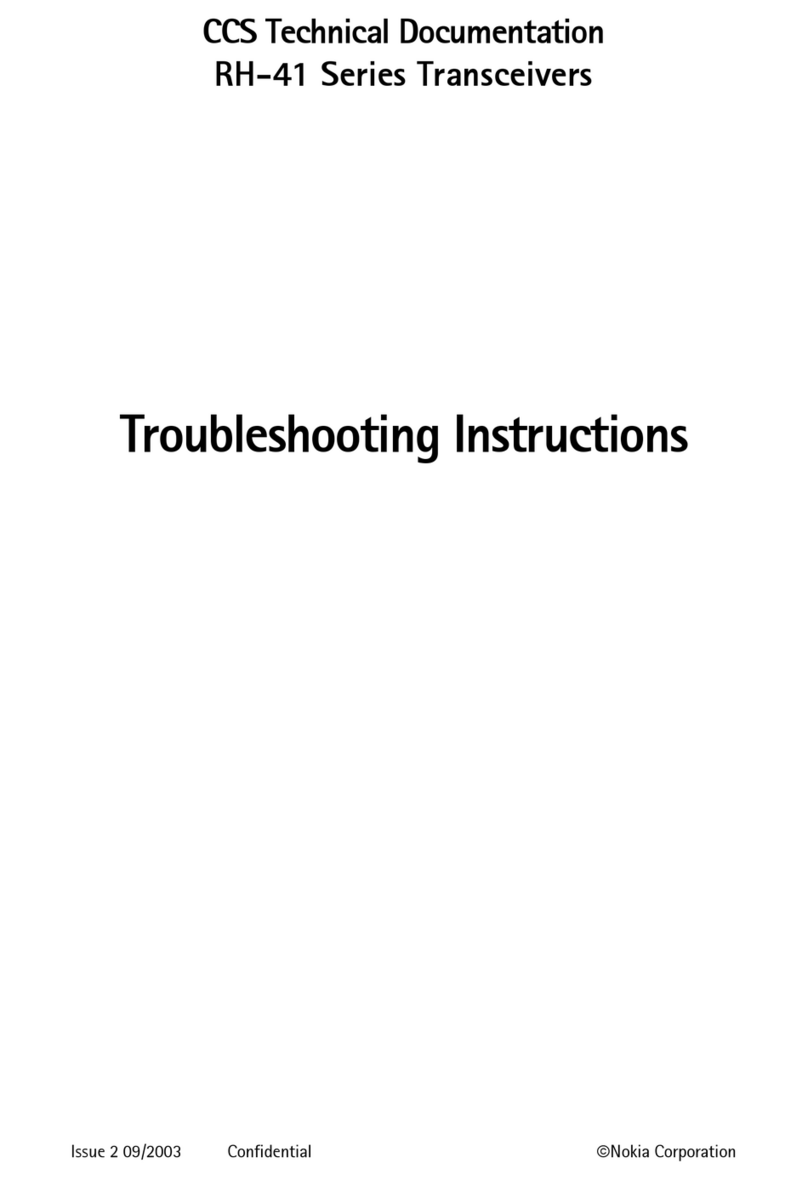
Nokia
Nokia RH-41 Series Troubleshooting instructions
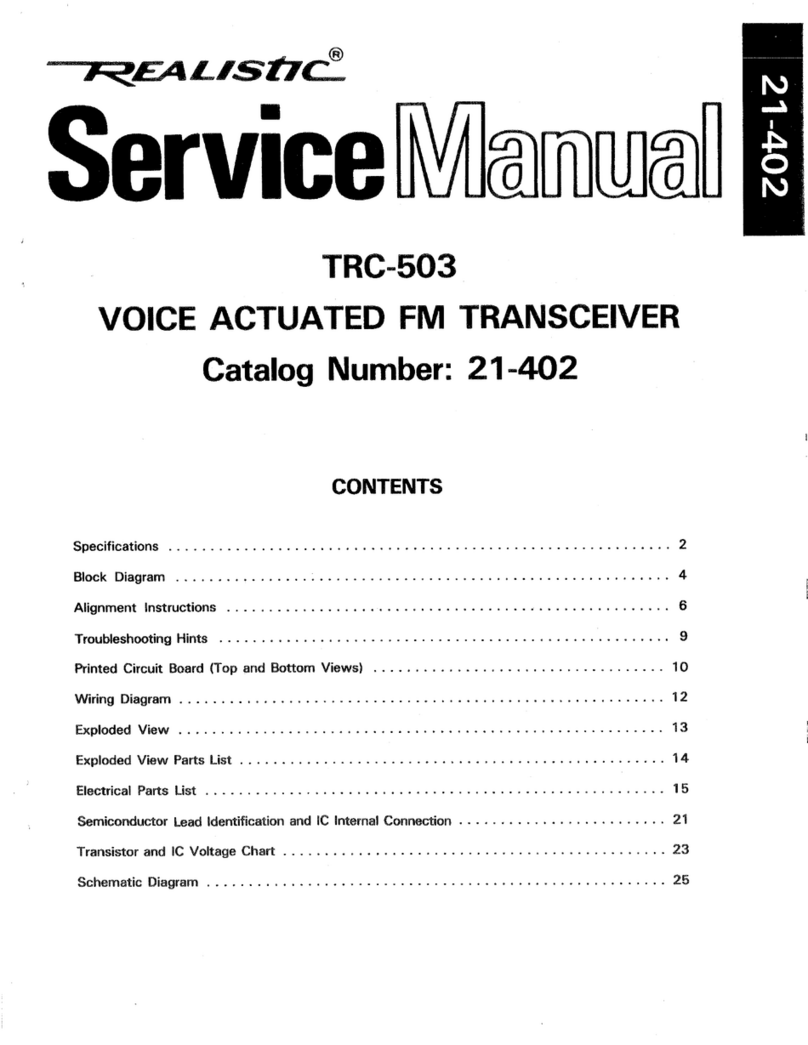
Realistic
Realistic TRC-503 Service manual
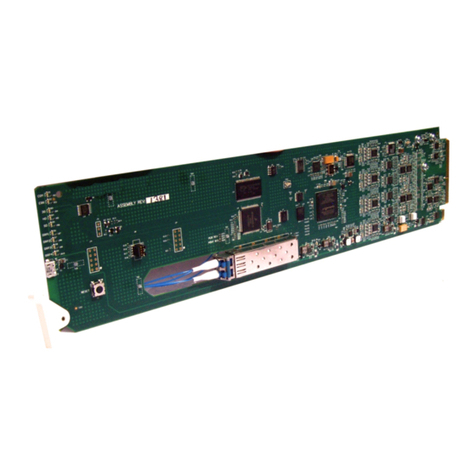
Cobalt Digital Inc
Cobalt Digital Inc 9433-EMDE-75/110 product manual
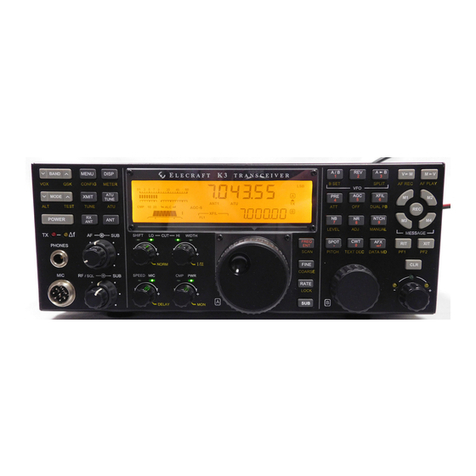
ELECRAFT
ELECRAFT KPA3 installation instructions
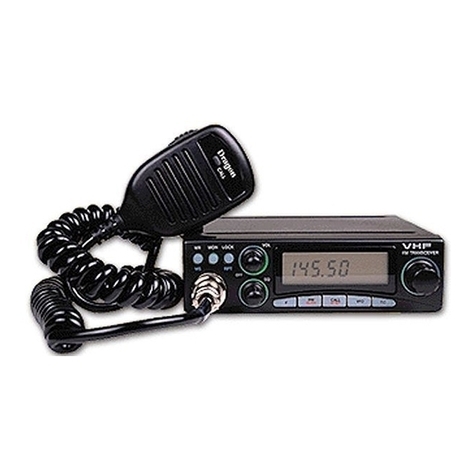
Albrecht
Albrecht AE 550 instruction manual

Vertex Standard
Vertex Standard VX-410 Series operating manual
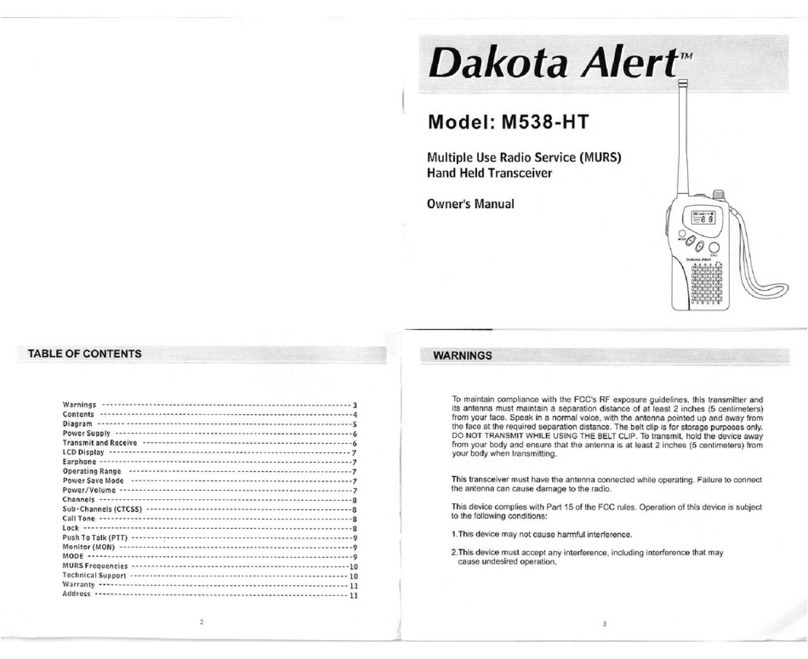
Dakota Alert
Dakota Alert M538-HT owner's manual
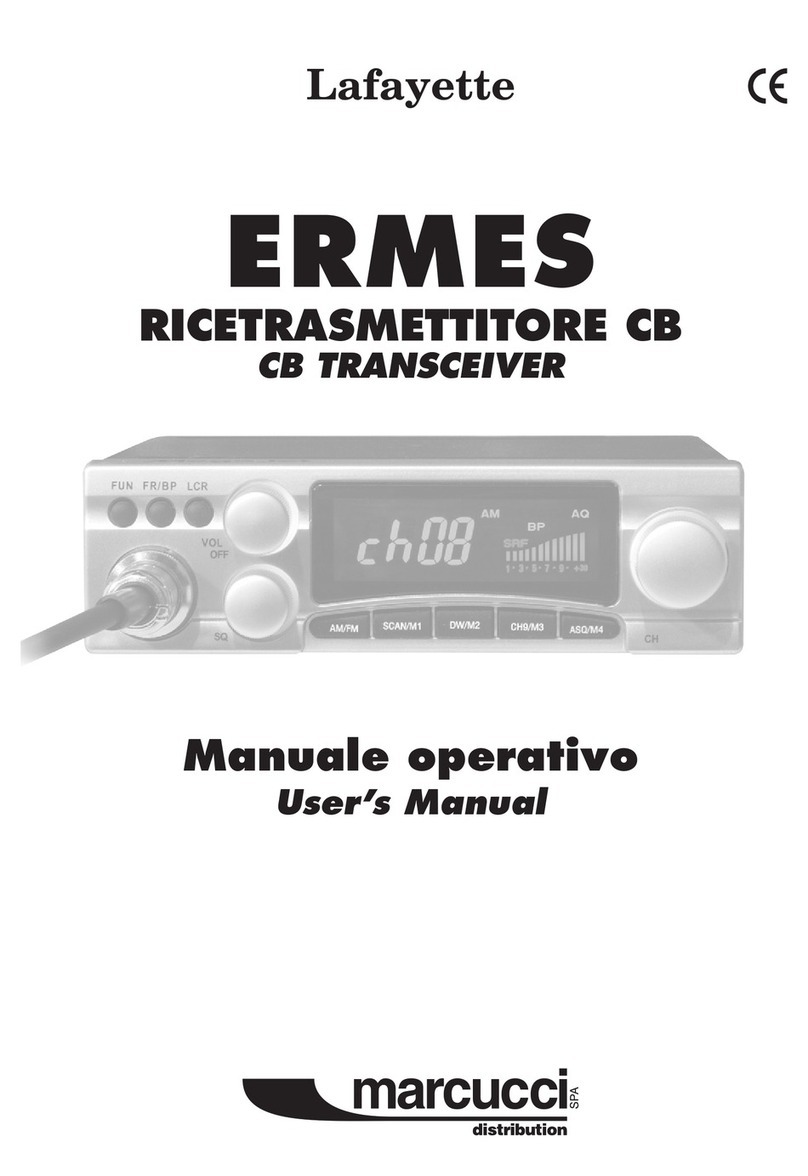
Lafayette
Lafayette ERMES user manual

Kenwood
Kenwood TK 3230 - FreeTalk XLS UHF instruction manual
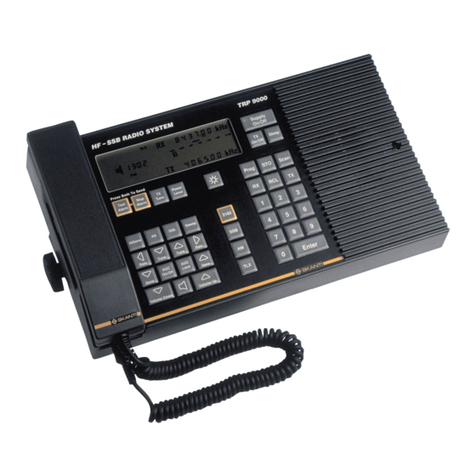
Skanti
Skanti TRP 9500 Technical manual
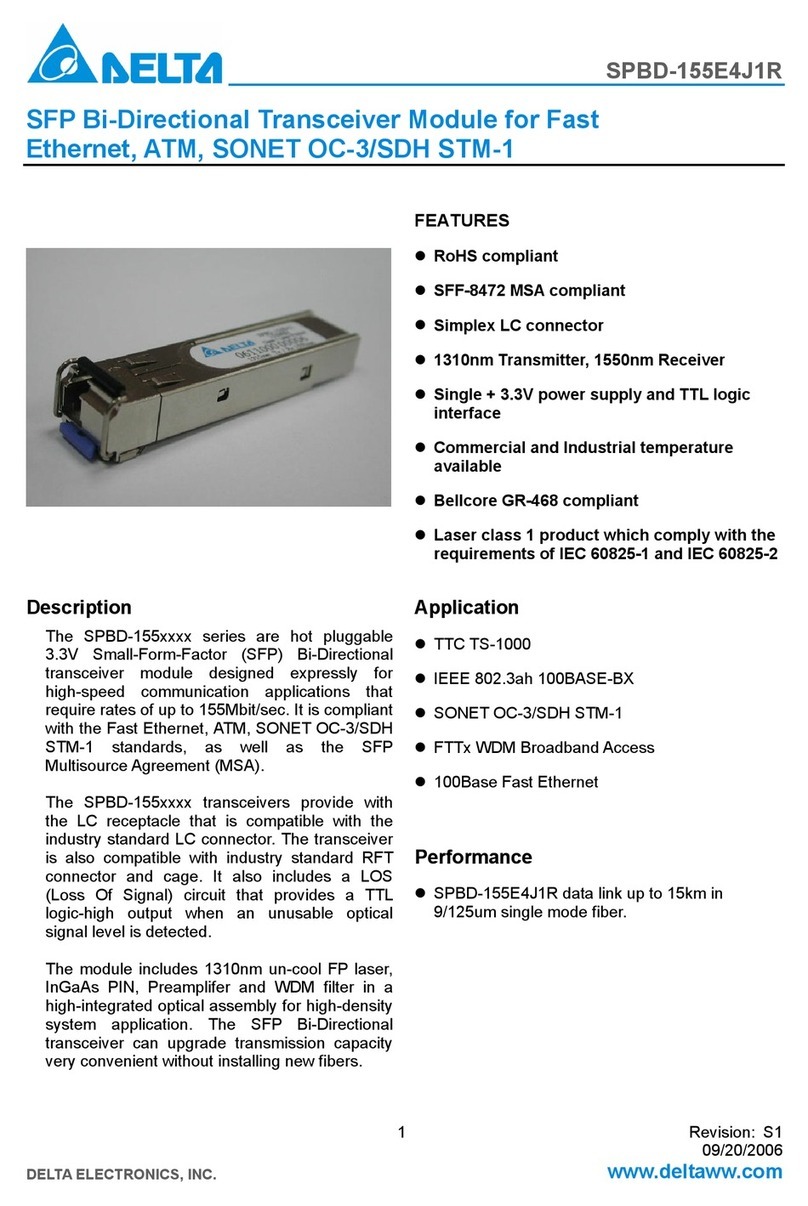
Delta Electronics
Delta Electronics SFP Bi-Directional Transceiver Module... Specification sheet
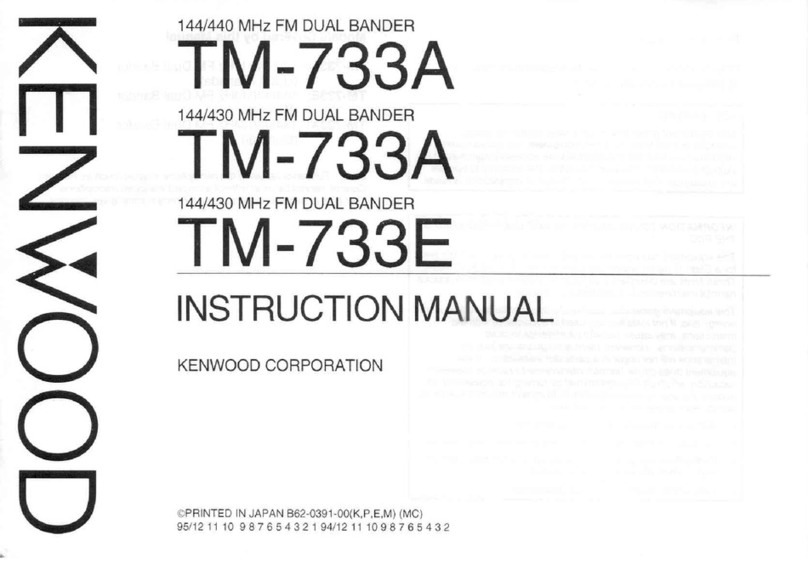
Kenwood
Kenwood TM-733A instruction manual

